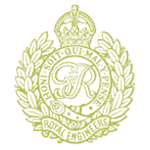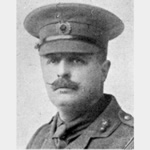Commemorated: | |||
| 1. Memorial: | Bethune Town Cemetery | II. B. 12. | |
| 2. Book: | The (1921) Masonic Roll of Honour 1914-1918 | Pg.129 | |
| 3. Memorial: | The (1940) Scroll - WW1 Roll of Honour | 41C GQS | |
Awards & Titles: | |||
Family :
Son of Thomas Herbert Marsh and Agnes Amelia Towers, his wife; husband of Grace M. Marsh, of 12, Honeybourne Rd., West Hampstead, London.Service Life:
Campaigns:
- The South African War 1880-1881, South Africa.
- The First World War 1914-1918, World-wide.
| Unit / Ship / Est.: 4th (London) Field Company |
| Action : The Battle of Neuve Chapelle and subsidiary actions |
Following a winter in the trenches the BEF was prepared to take the offensive against the Germans. The location was Neuve Chapelle, a small village in the front line below Aubers Ridge near Lille. Aubers Ridge was a low but significant hill and the intention at Neuve Chappell was to punch through the German front line, occupy the ridge and exploit with cavalry. It was a battle fought by two Corps of the BEF, the Indian Corps and IV Corps both largely consisting of regular battalions. It was to be preceded by the most violent artillery barrage of the war to date. Unfortunately in what was to be the start of the 'learning curve' for the BEF the artillery barrage, whilst violent, failed in some parts ? a failure that was to be costly and which delayed the assault and allowed the Germans to recover. Whilst the men were exceptionally brave they became bogged down as German machine guns and artillery stopped the momentum of the assault and by the end of the first day (10th March 1915) they were digging in. The following day the assault was repeated with fresh battalions but with no success. By the 12th March the Germans had recovered their poise, had brought in reserves and were ready to counter attack.
Neuve Chapelle (10-12 March 1915) was the first planned offensive battle by the BEF in France and achieved limited tactical success but not the expected breakthrough. It highlighted the problem of delay in execution that allowed the defending Germans to regroup, often consequent on small incidents and errors. Having stabilised the situation following the German sweep into France and the counter attack that eventually established static trench warfare on the western front, there was significant pressure on Britain to take a share of the burden from the French (who had without question had born the brunt of the fighting). Although the battle was effectively over by 12th March, the official battle nomenclature included actions in other sectors up to 22 April 1915 including the significant actions at St Eloi and at Hill 60 (Ypres).
Detail :
MARSH, HENRY HERBERT STANLEY, Major. 4th London Field Coy., Royal Engineers, 2nd London Division Son of Thomas Herbert Marsh, of London. Born Toronto, Canada, 26 Oct. 1875 and educated at Kent House, Eastbourne and Faraday House. He began work as an engineer under Sir Benjamin Baker, and in 1897 was appointed Assistant Engineer to the City and South London Railway. He was a member of the Royal Engineers' Lodge of Freemasons, of the Institute of Electrical Engineers, and of the Junior Institution of Engineers, and Vice-President of the Faraday House Old Students' Association. He obtained a commission in the 1st Middlesex R.E. (volunteers) in March 1900, and served in the South African War in command of the 2nd Service Section of that regiment for which he was mentioned in Lord Kitchener's Despatch of 29th July 1902. He received the Queen's medal with five claps. He was Gazetted Captain in 1913, and Major, 4th London Field Coy on the 10 September 1914. On 14th March 1915, he went with his company to France and was wounded by a shell at Cuinchy, 1st April 1915, while supervising a working party under fire, and died the following day. He was buried in Bethune Town Cemetery. The Adjutant wrote We have lost in your husband not only a friend, but a really good officer, whose value lay in his keenness and conscientious sense of duty. He was married with three children. We found the following patent application which given Henry Marsh's background as an engineer seems a further link: ORIGINAL PATENT APPLICATION NUMBER 6,747 FOR AN IMPROVED UNIVERSAL JOINT FOR ELECTRIC LIGHT FITTINGS AND THE LIKE (SOHO). (Hardcover) by Thomas Herbert & Henry Herbert Stanley Marsh. Marsh (Author) 1904
Masonic :
| Type | Lodge Name and No. | Province/District : |
|---|---|---|
| Mother : | Royal Engineers No. 2599 E.C. | London |
Initiated | Passed | Raised |
24th March 1906 | 26th May 1906 | 22nd September 1906 |
Listed as a 31 year old Engineer from London, in 1906 at the time of his initiation into the Engineer's Lodge. War service is included in his entry on the contribution register, followed by "Killed in Action."
Source :
The project globally acknowledges the following as sources of information for research across the whole database:
- The Commonwealth War Graves Commission
- The (UK) National Archives
- Ancestry.co.uk - Genealogy, Family Trees & Family History online
- ugle.org.uk - The records of the United Grand Lodge of England including the Library and Museum of Freemasonry
Additional Source:
- Founder Researchers : Paul Masters & Mike McCarthy
- Researcher : Bruce Littley

